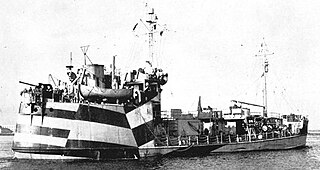
USS Suisun (AVP-53) was a United States Navy Barnegat-class small seaplane tender in commission from 1944 to 1955. It was named for northern California's Suisun Bay, which takes its name from the Native American Suisun tribe.
The second USS Whippet (IX-129), an Armadillo-class tanker designated an unclassified miscellaneous vessel, was the second ship of the United States Navy to be named for the whippet. Her keel was laid down on 31 October 1943 at New Orleans, Louisiana, by the Delta Shipbuilding Company under a Maritime Commission contract. She was launched on 15 December 1943 sponsored by Mrs. Will Camp Sealy, delivered to the Navy on 13 January 1944, and commissioned on 14 January 1944.

USS Millicoma (AO-73) was a United States Navy fleet oiler which served in the Pacific Theatre during World War II, winning eight battle stars for her dangerous work. Post-war she was recommissioned and was placed under the control of the MSTS with a civilian crew until finally assigned for disposal in 1987.
USS Saranac (AO-74), originally named the SS Cowpens, was a Type T2-SE-A1 Suamico-class fleet oiler of the United States Navy, and the fourth ship of the Navy to bear the name.

USS Wabash (AOG-4) was a Patapsco-class gasoline tanker acquired by the U.S. Navy for the dangerous task of transporting gasoline to warships in the fleet, and to remote Navy stations.

USS Sebec (AO-87) was a Escambia-class fleet oiler acquired by the United States Navy for use during World War II. She had the dangerous but necessary task of providing fuel to vessels in combat and non-combat areas primarily in the Pacific Ocean. For her valiant efforts, she received six battle stars during the war.

USS Ashtabula (AO-51) was a Cimarron-class fleet oiler of the United States Navy in service from 1943 to 1991. She survived three wars and was awarded eight battle stars for World War II service, four battle stars for Korean War service, and eight campaign stars for Vietnam War service. In the mid-1960s Ashtabula became the lead ship of her class, when she and seven other Cimarron-class oilers were lengthened ("jumboized"). She has been the only U.S. Navy ship to bear the name Ashtabula, after the City of Ashtabula which was named after the Ashtabula River in northeast Ohio.

USS Matar (AK-119) was a Crater-class cargo ship, converted from a Liberty Ship, commissioned by the US Navy for service in World War II. She was first named after Napoleon B. Broward, an American river pilot, captain, and politician; he was elected as the 19th Governor of the US state of Florida. She was renamed and commissioned after Matar, a binary star in the constellation of Pegasus. She was responsible for delivering troops, goods and equipment to locations in the war zone.

USS Megrez (AK-126) was a Crater-class cargo ship commissioned by the US Navy for service in World War II. Megrez was named after Megrez, a star in the constellation Ursa Major. She was responsible for delivering troops, goods and equipment to locations in the Asiatic-Pacific Theater.

USS Genesee (AOG-8) was a Patapsco-class gasoline tanker acquired by the U.S. Navy for the dangerous task of transporting gasoline to warships in the fleet, and to remote Navy stations.

USS Kishwaukee (AOG-9) was a Patapsco-class gasoline tanker acquired by the U.S. Navy for the task of transporting gasoline to warships in the fleet, and to remote Navy stations.

USS Nemasket (AOG-10) was a Patapsco-class gasoline tanker in service with the U.S. Navy from 1944 to 1959. She was scrapped in 2006.

USS Tombigbee (AOG-11) was a Patapsco-class gasoline tanker in service with the United States Navy from 1943 to 1972. She was then sold to Greece, where she served as Ariadni (A414) until 2003.

USS Calamus (AOG-25) was a Mettawee-class gasoline tanker acquired by the U.S. Navy for the dangerous task of transporting gasoline to warships in the fleet, and to remote Navy stations.
USS Kanawha (AOG-31) was a T1-M-A2 Mettawee-class gasoline tanker acquired by the U.S. Navy for the dangerous task of transporting gasoline to warships in the fleet, and to remote Navy stations.
USS Narraguagas (AOG-32) was a Mettawee-class gasoline tanker acquired by the U.S. Navy for the dangerous task of transporting gasoline to warships in the fleet, and to remote Navy stations.
USS Oconee (AOG-34) was a Mettawee-class gasoline tanker acquired by the U.S. Navy for the dangerous task of transporting gasoline to warships in the fleet, and to remote Navy stations.

USS Ontonagon (AOG-36) was a Mettawee-class gasoline tanker acquired by the U.S. Navy for the dangerous task of transporting gasoline to warships in the fleet, and to remote Navy stations.

USS Bollinger (APA-234) was a Haskell-class attack transport in service with the United States Navy from 1944 to 1947. She was scrapped in 1982.
USS Octorara (IX-139) was a tanker originally loaned to the Soviet Union during World War II and then returned to the United States in 1944. She was then commissioned by the U.S. Navy and served as a tanker for the remainder of the war.














